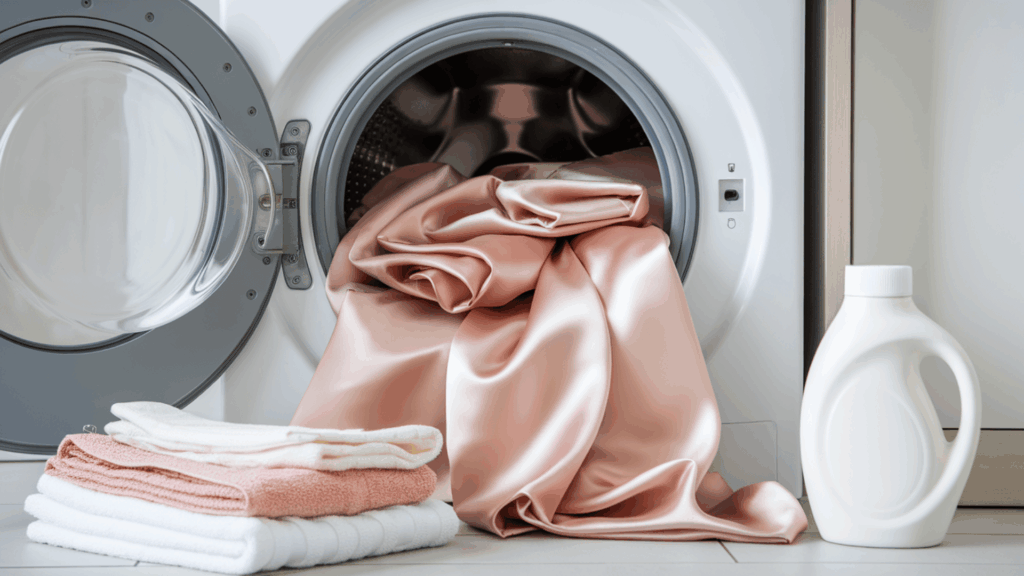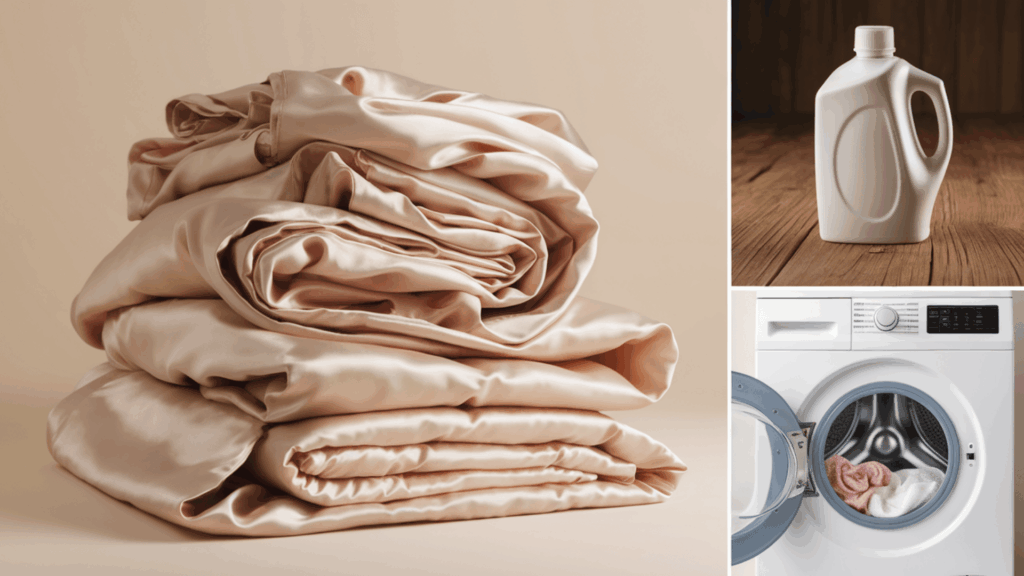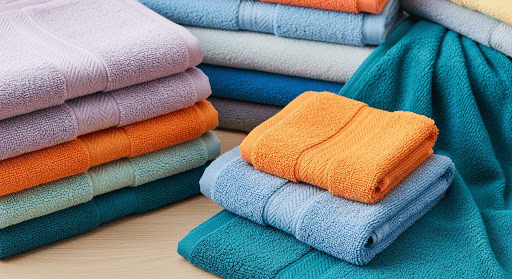Satin sheets aren’t just beautiful, they’re an investment in comfort and luxury. But to keep that glossy softness from fading, you need to treat them with care.
If you’ve splurged on a high-end set or found a budget-friendly version you love, proper care is key to making them last.
Satin can be a bit fussy: it dislikes harsh detergents, is sensitive to hot water, and tends to snag easily. That’s why knowing how to handle spills and store them properly can make all the difference.
This quick blog will walk you through everything you need to know, from treating stains the smart way to tips that preserve that silky-smooth texture over time.
You don’t need fancy tools or expensive cleaners, just a little know-how. Ready to keep your satin sheets soft, clean, and stunning? Let’s get into the simple steps that make luxury last.
What Are Satin Sheets?
Satin sheets are bedding made with a special fabric construction that creates a smooth, glossy surface on one side and a matte finish on the other.
The term “satin” refers to the specific way threads are woven together, not the material itself.
This unique construction pattern uses multiple threads passing over a single thread, creating that signature lustrous appearance and silky-smooth texture.
Most satin sheets available today are made from polyester, which makes them affordable and durable for regular machine washing.
Unlike cotton sheets that have a rougher texture, satin sheets allow easy movement during sleep and create less static electricity, making them a preferred choice for people seeking luxury and practical hair and skin care benefits.
Can You Wash Satin Sheets in a Washing Machine?

Machine washing satin sheets is not only safe but also the most practical and effective cleaning method for most households.
Modern washing machines with gentle cycles provide consistent water temperature control and proper agitation levels that hand washing cannot match.
The controlled environment prevents over-soaking, which can damage satin fibers, while ensuring thorough cleaning of oils, dead skin cells, and allergens that accumulate during sleep.
Most satin sheets made from polyester are specifically designed to withstand regular machine washing, making them more durable than many people realize.
The gentle cycle, combined with cold water actually extends the lifespan of satin sheets by maintaining fiber integrity.
When done correctly with appropriate settings and detergents, machine washing maintains the smooth texture and shine that makes satin sheets so appealing.
How to Wash Satin Sheets in the Machine

Machine washing satin sheets requires the right approach to maintain their smooth texture and lustrous appearance. Follow these simple steps for the best results:
Step 1: Prepare Your Sheets
Start by separating your satin sheets from the rest of your laundry. Never wash them with rough items, such as towels, jeans, or anything with zippers or buttons. These can snag and damage the smooth surface.
Turn your sheets inside out to protect the shiny side. If you have silk satin sheets, put them in mesh laundry bags for extra protection.
Step 2: Set Water Temperature and Machine Settings
Always use cold water. Hot water will shrink your sheets, damage the fibers, and make them lose their shine. Keep the temperature below 77°F if possible.
Set your machine to the gentle or delicate cycle. Use the lowest spin speed available. Don’t pack too many items in one load – your sheets need room to move freely.
Step 3: Choose the Right Detergent
Pick a mild detergent made for delicate fabrics. For silk satin sheets, use a silk-specific detergent if you have one.
Never use:
- Bleach
- Fabric softener
- Harsh chemicals
- Too much detergent
Follow the package directions for how much detergent to add. More isn’t better – it can leave residue on your sheets.
Step 4: Complete the Wash Cycle
Don’t let your sheets sit in the machine after the cycle ends. Take them out right away to prevent wrinkles from setting in.
Gently shake out the sheets and smooth any twists or tangles with your hands.
How Often Should You Wash Satin Sheets?
You can wash satin sheets just as often as regular cotton sheets – typically every 1-2 weeks. Proper washing helps them last longer by removing oils and dirt that can break down the fibers.
Signs your sheets need washing:
- They smell or feel oily
- You see stains or spots
- They’ve lost their smooth feel
- You’ve been sick
Regular washing won’t damage the quality of satin sheets when you use the right method.
How to Dry Satin Sheets Without Damaging the Fabric

Proper drying is just as important as washing when caring for satin sheets. The right drying method preserves the smooth texture and prevents damage from heat or rough handling.
Air Drying (Best Method)
Hang your sheets to dry away from direct sunlight. The sun can fade colors and weaken fibers. Choose a shaded spot with good air flow.
You can hang them on a drying rack, clothesline, or over a clean shower rod. Smooth out wrinkles while they’re still damp.
Machine Drying (If Needed)
If you must use the dryer, choose the lowest heat setting or air-fluff only. Remove the sheets while they’re still slightly damp – this prevents over-drying and makes them easier to smooth out.
Add a few wool dryer balls to reduce static and wrinkles. Never use dryer sheets with satin.
Never use high heat – it will shrink your sheets and damage the fibers.
Benefits of Satin Sheets

Satin sheets offer more than just a luxurious feel; they provide real benefits for your hair, skin, and overall sleep quality. Here’s why so many people choose satin over traditional cotton bedding.
Hair Health: Satin’s smooth surface reduces friction against hair strands, preventing tangles and breakage while you sleep. The low-friction texture also minimizes frizz and helps maintain your hairstyle longer between washes.
Skin Care: The gentle surface creates fewer sleep wrinkles and reduces skin irritation compared to rougher fabrics. Satin doesn’t absorb skincare products, allowing moisturizers and treatments to stay in place for better results.
Allergy Relief: Satin attracts fewer dust mites and allergens than cotton due to its smooth, non-porous surface. This creates a cleaner sleeping environment and reduces exposure to common allergens in the bedroom.
Comfort: The cool, silky texture provides comfortable temperature regulation, allowing for easy movement during sleep. The smooth surface prevents sheets from bunching up or creating uncomfortable friction against your body.
Common Washing Mistakes to Avoid
Many people damage their satin sheets without realizing it. These common errors can ruin the smooth texture and reduce the lifespan of your bedding.
- Using hot water – Heat shrinks fibers and destroys the lustrous finish
- Washing with rough fabrics – Towels, jeans, and zippers can snag and tear satin
- Overloading the machine – Cramped sheets can’t move freely and get damaged
- Adding fabric softener – Chemicals coat the fibers and reduce the smooth feel
- High-heat drying – Excessive heat melts synthetic fibers and causes shrinkage
- Ignoring care labels – Different satin materials need specific care instructions
Avoiding these mistakes keeps your sheets looking and feeling new for years to come. Take a few extra minutes to care for them properly, and you’ll enjoy their benefits much longer.
Caring for Satin Sheets: Stain Removal & Longevity Tips

Tackle stains fast by rinsing fresh spills with cold water. For tougher spots, soak in cold water with a gentle detergent for 15–30 minutes, then rinse and wash as usual.
For older stains, soak the full sheet for a few hours before laundering.
To make your satin sheets last longer, wash every 1–2 weeks, store in a cool, dry place, and rotate between sets to reduce wear. Be gentle when making the bed to avoid snags, and replace sheets when they lose their smoothness.
Investing in high-quality satin from trusted brands ensures that it stands up to frequent washing and maintains its feel over time. Treat them well, and they’ll stay soft and luxurious.
Satin vs Other Sheet Types

Choosing the right bedding material depends on your priorities and budget. This comparison helps you understand how satin compares to other popular sheet options.
| FEATURE | SATIN | COTTON | SILK |
|---|---|---|---|
| Material | Polyester/Nylon | Natural cotton | Natural silk |
| Price | $20-60 | $15-100+ | $100-500+ |
| Care Level | Medium | Easy | High |
| Hair Benefits | Excellent | Poor | Excellent |
| Skin Benefits | Good | Fair | Excellent |
| Durability | 2-4 years | 5-10 years | 10+ years |
Conclusion
Caring for satin sheets is all about gentle habits that help them last. Start by rinsing fresh stains with cold water; fast action really matters.
For older or stubborn spots, soak the sheet in cold water with a mild detergent before washing. Always wash gently, avoid heat, and skip harsh products.
Rotate your sheet sets to reduce wear and store them in a cool, dry space to keep that smooth finish intact.
When the fabric starts to lose its silky feel, it might be time to replace it with a high-quality set. Satin can stay soft and luxurious for years if treated well.
Have questions or tips of your own? Comment below, we’d love to hear how you care for your satin sheets!
Frequently Asked Questions (FAQs)
Can I Wash Satin Sheets Every Week?
Yes, you can wash satin sheets weekly if you handle them with care. Always use cold water and a gentle cycle to protect the fabric.
Will Machine Washing Ruin the Shine?
Machine washing won’t ruin the shine if you follow the right steps. Avoid hot water and high heat drying to keep the sheen intact.
What’s the Difference Between Washing Satin and Silk Sheets?
Silk sheets are more delicate and require even gentler care than satin. Use a silk-specific detergent and consider hand washing when possible.
How Often Should I Replace Satin Sheets?
With proper care, quality satin sheets can last between two to four years. Replace them when you notice signs of wear like fraying or dullness.








